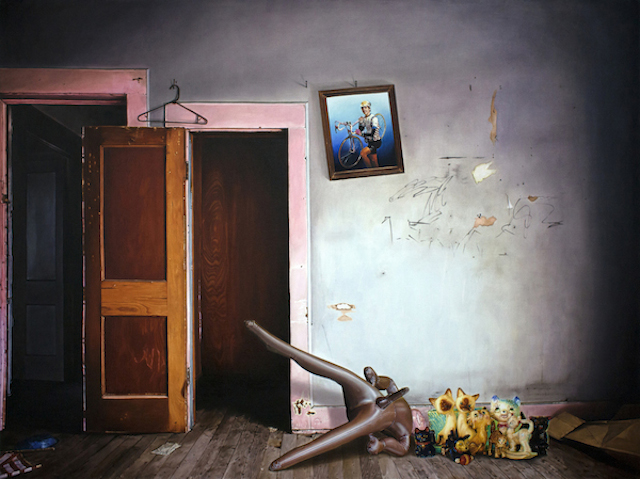Art
Pavle Pavlović: A Certain Dose of Provocation
The paintings of Pavle Pavlović depict both the expansive and minute, with highly detailed, tightly rendered subjects (or objects) offset by open, generic space. The effect is almost uncomfortable. Familiar, yet somehow “off.” Uncanny.
Pavlović’s work, although representational, does not exactly depict reality. Instead, he employs an almost curatorial process of hunting and gathering, pulling found images together in one painting to convey a particular idea. With several recent exhibitions under his belt, Pavlović is now gearing up for a new series of work. Here he tells us more about his approach, the ideas that interest him, and what’s next.
People often comment on the absurdity or morbidity of your work. I’m interested in what creates these feelings of aversion. It’s not necessarily the objects themselves – it’s the combination of objects, locations, and people. You put them together in ways that feel eerie or taboo. How? Why? What’s the point of departure for your work, and what is your process like?
I’m really glad that you asked me this, because this perception of my paintings is interesting to me as well. Frankly, it was never my intention to create morbid work or paintings that will shock someone, but it seems to me that a certain dose of provocation is sometimes necessary. As you said yourself, in my work, this is most often people, objects, and spaces that we encounter every day. I love to play with these, reverse the whole story, bring in another context, and sometimes try to bring about the absurd. I am trying to create a painting that has some dose of wonder in it, that will provoke questions and is thus more than mere decoration on the wall.
Even my way of working makes this possible, in some way. Often, my point of departure for a painting is some interesting phenomenon that I notice in everyday life, in some of the anomalies of the modern society in which we live. Analyzing this problem, I begin to collect elements that I need for the painting, mainly through the Internet, which leads to some sort of collage created from details that were not previously related. Basically, in the process of painting, which we know can sometimes last quite a while, this whole story is crystallized.
Can you tell us a bit about the tension between childhood/adulthood and innocence/deviance that appears in your work?
In the last series of paintings, I was quite concerned with this, especially through the question of memory. The initial idea was to reconstruct paintings of “blurry” memories from childhood by passing them through some story that preoccupies me now. Essentially, it wasn’t the painting itself that was important, but the impact that a certain event left on me. This reconstruction of memory was interesting to me, as was the ability of outside factors and information that we gather along the way to influence memory.
This is especially interesting today, in the era of the Internet and mass media, when we are literally bombarded with information. Sometimes it seems more and more difficult to distinguish between lived and virtual experience. From all of that came this peculiar dichotomy.
As viewers, we often try to find personal or biographical links between artists and their work. How do you feel about this? Do you experience misunderstandings about you as an artist, you as a person?
Honestly, I have never been too bothered by this. In general, the painting that I do is related to my own lived experience, but I have realized that through the whole process connected with my work, I actually get to know myself a little better.
Do you have any particular influences – artistic, literary, cultural, or otherwise?
In fact everything you mentioned has affected my work. It is difficult to set aside a certain segment that is especially important. I am a huge fan of film art, but music also has an important role, especially in the process of painting. Solarfall, the title of this year’s solo exhibition, is the name of a song by the band Immortal that had become a metaphor for the kind of world I was trying to create.
As for painting, the biggest influence for me is northern late Gothic and Renaissance painting, while today’s art is particularly interesting for its dynamics. There aren’t art movements at this point. You can do whatever you want. You can be versatile and there are no boundaries.
If you could pick one painting that you really love, or that does a particularly good job of representing you or what your work is about, which would it be and why?
It’s hard for me to single out one specific painting that is particularly important to me. I think that it’s a little too early to come to such a work. Right now, it’s much more important that there is still space where I can develop and experiment with the medium itself. Even now, much of what interests me in painting is what I would like to try. Discovering new spheres and possibilities in some way creates excitement and encourages me to keep doing what I’m doing. I have the feeling that the moment that I realize I have reached my potential could lead to some sort of stagnation.
What’s next for your work?
At the moment, I am working on a new series of paintings for 2016. The initial idea was the reconstruction of touristic photographs and postcards, i.e. their peripheral parts. Basically all of this is still in the development phase, and we’ll see where it will take me in the end. In terms of medium, I’m currently exploring different surface effects. Recently I’ve been underpainting with egg tempera and experimenting with some of the possibilities that it offers. My goal is to achieve a vibrant surface for the painting before I begin to paint with oil colors.








